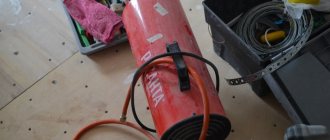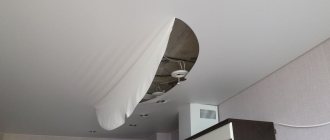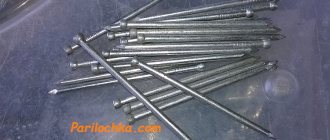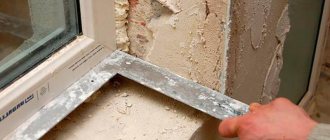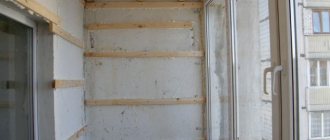What cases are covered by the guarantee?
Before filling the hole, review the contract with the contractor and re-read all the conditions.
Pay special attention to the section of duties and responsibilities of the construction company that installed the suspended ceiling. Usually companies provide a guarantee
But there are a lot of nuances that unscrupulous contractors take advantage of:
- The materials come with a manufacturer's warranty. Builders will say that complaints must be sent to the company that manufactured the components.
- Too long. The text indicates, for example, 5 or 10 years. But the company has already been liquidated, and there is simply no one left to make demands.
- Excessive conditions for providing warranty repairs. It happens that the agreement states that the homeowner is obliged to provide access to the work site: remove baseboards, remove furniture, etc.
But most of all the controversy arises over the warranty case or not. A puncture, cut, or rupture caused by the actions of the apartment owner will not be repaired free of charge. But any defect will have to be eliminated: insufficiently reliable fastening of the retaining profile, low-quality components, poor tension, defects left by the tool during installation.
What cases are covered by the guarantee?
Repairs are performed free of charge when defects arise due to the fault of the manufacturer or installer. The main situations are as follows:
- The seam between the pieces of PVC film has come apart.
- The frame of the stretch ceiling extends from the wall.
- The film or fabric is not tucked into the baguette properly.
- The harpoon is not soldered well enough.
In the first case, the manufacturer gives a guarantee on the quality of the soldering and is obliged to install a new sheet free of charge. In other situations, warranty repairs are performed.
Another possible cause of damage is crumbling pieces of plaster or other finishing.
In this case, it is important who did the preliminary work. If the company installs the ceiling, then the craftsmen must eliminate the consequences free of charge
And if you prepare it yourself, you will have to pay for repairs.
Non-warranty cases include the following situations:
- the cabinet or cornice was installed carelessly and the film was pierced or cut;
- homeowners independently dismantled the ceiling and damaged the canvas;
- the neighbors caused a flood and the film burst under the weight of the water.
If handled carelessly, the stretch ceiling can easily be punctured and torn. It can also crack from excessive pressure. But often a complete replacement is not required; cosmetic repairs are enough. Some types of work are even covered by a guarantee.
Situations when repair is impossible
Some damage to the stretch ceiling cannot be restored: in this case, the canvas will have to be completely replaced.
We are talking about the following situations:
- The canvas is cracked at the seam. All attempts to glue the material will only make the situation worse. This defect can only be eliminated by re-tensioning the material.
- If the suspended ceiling has moved away from the wall. A very difficult breakdown that will require complete dismantling of the system to fix. Removed profiles and baguettes must be strengthened or replaced.
The best method for repairing a cut in a stretch ceiling is to prevent it from occurring. If an unpleasant situation does occur, before starting self-repair, you need to soberly assess your strength. If you don’t have confidence in your own abilities, it’s better to call professionals. It often happens that clumsy repairs make the situation even worse.
Stretch ceiling. Small cut
What to do if the suspended ceiling is damaged? A small cut can usually be repaired. With larger holes it is more difficult. But it's best to take care to prevent damage. And for this you need to know for what reasons the cuts occur.
What causes cuts and how to prevent them
A large or small cut on a stretch ceiling most often appears from careless actions with sharp objects nearby. The material is most sensitive to mechanical impacts in the first few days after installation. During this period, the canvas is highly stretched, and the owners have not yet learned how to handle it carefully.
These sharp objects are usually metalworking tools with sharp edges. Electrical appliances with rotating parts (drill, grinder) are also dangerous.
Children's games also often cause trouble. When children play, toys and other things can damage the film. For example, an innocent game with a radio-controlled helicopter can seriously damage the surface.
You should be careful when installing furniture. The corners of the cabinet cannot compare with the sharpness of a knife, but they are quite dangerous for sensitive fabric.
Polyvinyl chloride film does not like temperature changes. Due to frequent jumps, it loses its elasticity and may burst over time. Therefore, it is not advisable to install PVC in unheated rooms; in such rooms it is better to install a fabric ceiling.
Sometimes the cause of integrity violations can be inept cutting and installation.
If a cut occurs
If the hole is tiny - no more than 1 millimeter - it is enough to coat it with glue. The canvas will no longer unravel, and the hole will remain invisible.
When a stretch ceiling is damaged by a small cut, you immediately need to stop its growth. Scotch tape will help. It is better to use not an ordinary one, but a double-sided one or a painting one.
After “first aid”, you should assess the extent of the damage and understand whether it is covered by the warranty. This is, for example, a tear along the seam or separation from the profile. As long as the warranty is valid, and the trouble did not occur through the fault of the owners, there is no need to undertake repairs yourself. It makes more sense to contact the company that installed the structure.
When the cause of the break is careless operation, the craftsmen will have to pay or, if possible, make the repairs themselves.
Film repair
When the hole in the PVC film exceeds 5 cm, it is wiser to call in specialists. You may even have to completely change the coating. But, if there is a small cut on the stretch ceiling, then there are 2 ways to solve the problem.
- When the cut is no more than 10-15 cm from the wall, it can be hidden in a baguette. To do this, you need to dismantle part of the canvas from the profile, cut the material to the cut point, and glue the harpoon along the edge of the canvas. Then, you need to heat this area with a heat gun or a hair dryer and smoothly tuck the canvas into the profile using a special spatula.
- If the hole appears far from the wall, there is only one way out - stick a patch on it. A clear adhesive or sealant is used. The patch will not spoil the look if it is decorated decoratively in the form of a star or flower. You can also install a ventilation grille or an additional lamp at the site of the gust.
Fabric repair
Repairing fabric coverings can also be approached in two ways.
- You will need nylon threads to match the color of the fabric. It is necessary to carefully sew up the hole if it is not large (up to 10 cm). Additionally, it is worth painting the ceiling with water-based paint to hide the seam.
- Glue on a patch from the remnants of the fabric. It is best to glue the patch onto the fabric with colorless glue, and then you need to paint the entire surface of the ceiling.
A large hole over 10 cm long cannot be disguised. In this case, it is necessary to replace the entire blade.
When should you not glue the material?
Not in every situation it is permissible to seal cuts in the tension fabric. If the tear occurs along the seam, then gluing is not only useless, but also harmful. Only re-tensioning will save you here. There is no point in gluing even if the membrane has separated from the wall. This will also require dismantling and reinstalling the profiles.
Of course, it is quite possible to fix a small cut in a stretch ceiling without outside help. But, if there is an opportunity to entrust the matter to professionals, you should not neglect it.
Possible difficulties
Rips and punctures in fishing equipment may need to be repaired again. It is difficult to remove the remnants of the previous fixing composition; the glue is connected to the base at the molecular level. When cleaning the surface, do not use force; mechanical impact can lead to damage, increasing the area of \u200b\u200bthe rupture.
It is worth abandoning aggressive compounds and solvents. It is optimal to use abrasive materials, such as zero grade sandpaper. Residues of glue must be removed very carefully so as not to damage the base.
Rules for working with glue:
- You must first degrease the surface - use solvent, acetone or gasoline. It is better to sand the edges of the seam to be fixed for better fixation. Neoprene products are coated only with solvent and do not require the use of abrasive paper.
- To speed up the gluing process, you should use a construction or regular hairdryer - a hot air stream activates the process.
- You need to work with various adhesives in a well-ventilated area. You can repair equipment outdoors provided the humidity is no more than 50% and the temperature is from 15 to 25 °C.
- To check the quality of the repairs done, you don’t need to go into nature. It is enough to use a flashlight or table lamp. Go into a dark room and place a light source inside your overalls or boots. It is recommended to check your equipment before each fishing trip.
Share link:
When should you replace a suspended ceiling?
Not all cases of mechanical damage can be corrected. The PVC ceiling film will have to be completely changed if:
- The film broke through the joining seam. Moreover, the scale of the damage is too large and the canvas continues to diverge.
- Neighbor's flood. Only high-quality PVC sheets can withstand water. After removing moisture and drying, this film quickly returns to normal. But fabric ceiling coverings will have to be completely replaced if there is flooding from above. The fabric absorbs dirty water and after drying becomes untidy, loses its appearance and becomes covered with ugly stains.
- The holes are too big. When neither patches nor applications can save the situation.
- End of service life. On average, a suspended ceiling is designed to last 10–15 years. After this time, the ceiling material gradually loses its qualities and deteriorates.
How to fix a ceiling?
If the damage is covered by a warranty case (the warranty period has not yet expired and the break occurred without your participation), you should call specialists from the company that installed the ceiling, and they will fix it for you free of charge, and will also give you a warranty period for the work performed! Options for self-repair in case of non-warranty cases will be described below depending on the types of ceiling.
First of all, if mechanical damage to any type of ceiling is detected, urgent measures should be taken to prevent the cut from increasing in size. To do this, you will need double-sided/masking tape. In the absence of such materials, ordinary tape will do.
Next, we will tell you how to repair the ceiling yourself if it is damaged.
Fabric
Let us remind you that the fabric ceiling is made from “breathable” natural or synthetic fibers. Mechanical damage to the fabric panel can be eliminated quite easily in one of two ways.
Using nylon threads. Nylon threads are sold in most sewing stores; you just need to choose the right color. This method is used if the cut is thin and has smooth edges. The cut is carefully sewn up with thread, and the task is completed!
Using a patch. This method is advisable to use in case of large damage, but if the length of the gap is more than 30 cm, the ceiling will have to be completely replaced. The material for the patch can be a piece of the ceiling material (if available), glass wallpaper, or, in extreme cases, a piece of thick fabric matched to the color.
The repair sequence is quite simple: a patch is cut out with a margin of about 2 cm at the edges, glue is applied to the patch, and then this patch is pressed against the damaged panel from the inside. You cannot press too hard; this may have consequences in the form of sagging of the ceiling at the repair site.
Excess glue is removed, and after drying, the area is treated with water-based paint from a spray gun.
Film
The canvas for such a ceiling is made of polyvinyl chloride (PVC), due to which it has a smooth glossy or matte surface.
If there is mechanical damage to the PVC sheet measuring more than 2 cm, you must contact specialists who will most likely advise you to completely replace it.
If the cut is small, you can try to repair it yourself.
The repair method depends on the location:
Hiding the cut in the groove of the baguette. Can be used if the distance from the cut to the edge of the baguette does not exceed 15 cm. You will need a piece of antenna cable and glue. The cable is glued next to the cut parallel to the baguette. While the glue hardens, a hair dryer is prepared for use. Then the cut area is heated with a hairdryer and carefully pulled to the edge of the baguette using a cable. The cable is tucked into the groove of the baguette using a flat and blunt tool.
You can also use any other adhesive designed for repairing suspended ceilings.
In addition to the usual patch, there is an option to make an unusual decorative one on a damaged ceiling. A patch made in the style of wallpaper will look especially interesting.
Installation of functional elements in damaged areas. In place of the cut, you can install an additional lamp, a false ventilation duct grille or a fire alarm sensor. But first you should protect the cut from spreading with a special plastic ring. Once the area is secured, you can begin installing the light or grille.
This method is usually used in offices and public spaces, but it is also applicable to the bathroom or toilet.
- Disguise with a patch or applique. If you have some imagination, damage near the chandelier can be masked with a decorative element, which will not only save you from the hassle of replacing the ceiling, but will also update the room. If you play with shape and color, you can get a great design move.
- It is possible to hide traces of melting or burning using a special ring made of heat-resistant plastic, which is installed around the lamp. However, if the damage length is more than 20 cm, the blade must be replaced.
Strength characteristics of different types of canvases
It is much more practical to initially take all measures to prevent damage to suspended ceilings than to heroically eliminate them later. One way is to choose the most durable material possible.
There are two types of tension fabrics:
- Fabric. The raw materials for their production are natural or synthetic fibers with a porous surface. This allows the ceiling to “breathe”. The material copes well with temperature fluctuations, mechanical stress and can be additionally painted. This allows you to hide the joint area (if there is one) and eliminate minor damage. The disadvantages of fabric panels include their weak resistance to external pressure, weak elasticity and limited decorative equipment in terms of effects and shades. The fabric allows water to pass through, so when flooded from above, all the liquid ends up in the room.
- PVC films. Due to their high elasticity, they cope well with increased pressure, hide the defects of the main floor well, and do not accumulate dust on their surface. They can be washed with a soft sponge without using aggressive products. The weaknesses of stretch PVC film are susceptibility to mechanical damage, sensitivity to temperature fluctuations and difficulty in repair.
We carry out the correction
There are several ways to eliminate trouble after damage to the ceiling sheet.
Method No. 1
- We select nylon threads to match the color of the ceiling installed in the room.
- We apply a neat, precise seam using nylon thread.
Method No. 2
- If you have pieces of material left after installing the tension covering, use them. If not, use soft, thin plastic.
- Decide how you want to glue the patch and what shape it will be. If the cut is located in a corner, it is better to make a shaped element and apply it in all corners of the room.
- Glue the cut out patch using super glue. Use appliqués as patches.
How to repair a small puncture?
A small hole in a PVC ceiling can appear if you work carelessly with tools. Such damage can be repaired regardless of the material from which the coating is made.
Before starting work, it is necessary to secure the damaged area with tape. This will prevent the hole from increasing in size. If the damage is located somewhere inconspicuous, you can simply seal it with a circle cut from identical material. This will help restore the tightness of the coating. If such a patch matches the color of the ceiling, it will be invisible from a distance of more than 3 meters. If the puncture is located in a noticeable area of the ceiling, then when repairing, you can simply stick a beautiful PVC applique on top of the patch. It will hide the defect and give the surface an aesthetic appearance. To make this design seem visually complete, you can add a few more similar decorative elements.
How to glue PVC applications? A special adhesive composition is suitable for this purpose. First, the surface of the film must be degreased. Construction solvents should not be used as they may damage the material. Mild detergents work well. The glue should be used in accordance with the instructions indicated on the package. As a rule, these are quick-fixing compounds that adhere to the surface within a few seconds. If the patch is installed incorrectly, the repair procedure will have to be repeated. The patch is glued directly to the ceiling covering. After setting, the adhesive layer hardens and forms a kind of reinforcing layer, which prevents further increase in the size of the damage.
Closing the cut
This aspect deserves special attention. Suppose there is a small cut on the stretch ceiling
What to do in this case? If the defect appears in a part of the ceiling located far from the edge of the wall, then you can try the following method: install a lamp or ventilation grill in place of the hole. To prevent further stretching of the PVC film, experts recommend securing a plastic ring around the hole. Its inner part must be cut out to install the lamp. This method is especially effective for minor damage.
The simplest and easiest way to hide damage is to install spotlights. This is done quite simply and does not take much time. Difficulty can only arise when laying additional wires under the covering. But even if you can’t do this, don’t despair. An unlit light fixture will still look better than a damaged ceiling.
To achieve greater persuasiveness, you can install several lamps, observing the principle of symmetry. Then they will look as if it was the designer's original idea
Here it is important to calculate and draw everything correctly
To install the lampshade you will need a simple utility knife and plastic glue. The lamps are equipped with decorative rings. The cut should be inside this element. We simply coat its outline with glue and apply it to the damaged ceiling.
The adhesive composition sets quite quickly. After just a few seconds, you can cut holes inside the ring and place the lamp there. Try not to leave excess glue on the coating. Once they dry out, they will be impossible to clean.
This is the easiest way to seal a stretch ceiling after a cut. Unfortunately, its use is justified only for small damages that fit the size of the lamps. If we are talking about a large cut, you will have to use more radical methods.
How to repair a cut on a film stretch ceiling?
If the cut occurred on a film ceiling, then first you need to estimate its size. If the latter exceed 2 cm, then it is better to seek help from specialists. It is quite possible that it would be more advisable to replace the coating rather than repair it.
Method number 1. If the cut on the PVC film of the stretch ceiling is small in size, you can repair it yourself, taking into account all the nuances of such an event. If the cut occurred quite close to the wall (at a distance of up to 15 cm), then it can be hidden in the groove of the baguette. To do this, you need to stock up on 10 cm of antenna cable and glue. First, the cable needs to be glued close to the cut so that it is parallel to the baguette. You need to wait until the glue hardens well, and then use a hairdryer to heat the film.
Heat the cut area with a hair dryer
Directing warm air to the cut area, you need to smoothly pull the cable towards the wall, and then tuck it into the groove of the baguette, using a flat, blunt tool. If folds have formed during the work, you can get rid of them in the same way: glue the cable along them, heat the canvas, pull it to the wall and tuck it into the groove.
Prices for glossy stretch ceilings
glossy stretch ceiling
Repairing a cut near a wall
Method number 2. In a situation where the cut is far from the wall, there is only one way out - gluing a patch. It needs to be cut out from the remnants of the film, lubricated with transparent sealant or glue. Next, you need to remove the tape from the cut area and apply a patch there. Excess glue must be removed and the patch fixed for a while for better adhesion.
Decorative patch on a stretch ceiling
A small patch on a PVC stretch ceiling can be made decorative by cutting it in the shape of a flower, month, star, etc. A patch cut to match the color of the wallpaper will look especially impressive. For a more harmonious decor, you can cut out several shapes and arrange them beautifully.
- It is better not to repair holes in the canvas that have formed in its central part yourself, so as not to aggravate the situation.
- One of the options that can correct the situation is to install an additional lamp or ventilation grille at the site of the damage. To save the ceiling in this way, you first need to protect the coating from spreading at the cut site by installing a protective plastic ring. After this, you can install a light fixture or ventilation grille.
- If the cut occurs in the immediate vicinity of the chandelier, then it can be successfully disguised with the help of a decorative element. For example, use a piece of mirror or a polyurethane plate for this. As a result, the place of damage will be hidden, and the room will be decorated in a new way.
There are some requirements for the glue that is used to seal cuts in a suspended film ceiling. Firstly, it must be transparent - otherwise, unaesthetic white spots will remain on the ceiling. Secondly, the glue must harden quickly without destroying the polyvinyl chloride fabric during the drying process. Experts in the restoration of suspended ceilings advise using Cosmofen glue, which quickly and efficiently connects parts of the canvas without leaving marks. You can buy this product at regular hardware stores and building supplies departments. If “Cosmofen” is not found on sale, then you can ask the seller to provide a special glue for repairing suspended ceilings.
Prices for Cosmofen glue
glue Cosmofen
Glue "Cosmofen"
There are situations when suspended ceiling structures cannot be sealed and even professionals with extensive experience will not undertake this.
Ways to eliminate cuts
Repairing a cut in a stretch ceiling is not a difficult task, but it requires careful and precise movements. The method for solving the problem depends on where the cut is located: close (no further than 30 cm) from the baguette, or at a considerable distance from it.
If the cut is near a wall
- The edge of the film, located opposite the problem area, is removed from the baguette. Next, take out another 20-25 cm of film on the left and right. They find that its edges are wound into a harpoon, a strong elastic strip that is inserted into the baguette.
- Using a sharp knife (preferably a stationery knife), cut off the film along the lower (back) part of the harpoon. That is, they cut off his so-called “skirt”.
- Use a smooth, flat line to cut off the area with the defect.
- Apply glue to the harpoon and carefully, evenly glue the canvas to it. This is how cuts on suspended ceilings are sealed, where the problem area is near the baguette.
- Next, using a regular hairdryer, heat the film, stretch it and tuck it into a baguette. To season, you will need a spatula, the blade of which will have to be made blunt and rounded.
If the cut is far from the wall
Repairing suspended ceilings after a cut away from the walls requires a piece of film similar to the one that was stretched. You will also need glue and scissors. The visual defect of the canvas can be eliminated only by applying a patch. So you have to cut and glue. There is no other way to repair suspended ceilings after a cut with your own hands.
The result of the work may not please you. But this problem can also be solved. Today there are many different, beautiful and light-weight accessories for decorating walls and ceilings on sale. One of the most popular are spectacular butterflies. You can choose one that suits your interior design and glue it to the patch.
We found out how to remove a cut on a suspended ceiling. Now you need to understand what glue to use in your work.
Types of glue for repairing suspended ceilings
Experts from manufacturers recommend focusing on the COSMOFEN or COSMOPLAST adhesive lines, and only with their help to restore a suspended ceiling, repair cuts and eliminate holes. The most suitable for these works are COSMOFEN CA 12 and COSMOPLAST 513, 500, 500L
The first (COSMOFEN) is designed for use by specialists installing plastic windows. The COSMOPLAST series allows you to choose the adhesive that is most convenient in terms of hardening time. This is a very important point, since the speed of work is different for everyone.
For those who are leisurely and focused on quality and accuracy, COSMOPLAST 500 or 500L is suitable. Their hardening time is 3 and 4-5 seconds, respectively. If the work needs to be done quickly, but with possible further adjustments, it is recommended to use COSMOPLAST 513, the setting time of which is about 15 seconds. Enough to fix something.
Craftsmen who repair stretch ceilings successfully repair cuts using inexpensive types of glue. They consider Contact to be one of the best, and recommend that beginners use it. Using this glue, it is most convenient to repair suspended ceilings with your own hands. “Contact” is absolutely transparent, it sets quickly, but there is time for adjustment.
Causes of ruptures and solutions
To figure out where the holes in your ceiling came from, whether they can be removed, and whether it’s worth taking on the task yourself, read the information below.
Types of damage to stretch ceilings
Thin vinyl film is a fairly durable material that can withstand heavy loads. The only thing he does not tolerate is exposure to sharp objects.
But film rupture is not necessarily caused by them. Often the cause is manufacturing or installation errors or poor quality of the film itself.
- You can damage a suspended ceiling with your own hands if you handle it carelessly. For example, when gluing wallpaper and trimming its top edge. Or when accidentally poked with a spatula, ski pole or other sharp objects.
- Manufacturing defects include poor welding of seams and poor-quality gluing of the harpoon to the edge of the canvas.
- Installation errors can be different - from non-compliance with technology to damage to the canvas during the installation of spotlights.
- Finally, cheap, low-quality film often breaks due to strong tension.
The last three points are warranty cases.
Note! If your ceilings were installed by a legal company, and you have a contract in hand, you cannot try to fix anything yourself!
Contact the installers, they must do everything at their own expense. If the ceiling cannot be repaired, the cost of a new canvas will also fall entirely on their shoulders.
How to find the cause and eliminate defects
Carefully inspect your injuries to understand the cause of their occurrence:
A break in the weld is definitely not your fault. This is a “shop” defect that must be corrected by the manufacturer. If it is long, the canvas will have to be completely replaced.
The fabric could tear at the lamp if the hole was not reinforced with a tread ring during installation, or if it was poorly glued. Careless handling of the lighting fittings could also lead to this result.
For reference. Even if the canvas has to be completely replaced, it will cost you much less than the initial installation, since the frame is not dismantled and the new canvas is attached to it.
If the gap is located at the very edge of the ceiling, make sure that the fabric has not peeled off from the harpoon. If at some distance from it, this may be a result of overtension or poor quality of the film.
Advice. In controversial cases, an independent specialist from another company will help determine the cause of the defect.
If you are sure that you yourself have damaged the canvas, self-repair is possible in some cases, but is highly undesirable. In any case, you can only seal the tears near the lamps with transparent tape to stop the film from spreading, or with a piece of the same material. For this you will need special glue. Another thing is the wall gap.
If it is no further than 2-3 cm from the edge, you can try to re-tighten the canvas. Detailed instructions on how this is done are given in the article “Repairing suspended ceilings: do it yourself, or call a specialist?”
- Another option is to glue a protective ring around the gap, cut out the film inside and insert a ventilation grille, lamp or other “trick” into the hole.
- Finally, you can glue a decorative self-adhesive sticker over the hole.
We would not recommend that you undertake reupholstery without sufficient experience. It is better to temporarily seal the edges of the tear with tape and repair the ceiling when funds become available.
What types of deformation are considered a warranty case?
If damage to the ceiling film occurs due to improper work, the repair of the stretch ceiling is covered under warranty. The installer is obliged to replace the PVC sheet in the following situations:
- the butt seam between the PVC film sheets has come apart;
- the frame of the paintings began to come away from the wall;
- the film or fabric is poorly tucked into the baguette used;
- The harpoon fastening system used during installation was poorly soldered and began to come off.
All such situations are covered by warranty and are subject to free repair or replacement. But they must be specified in the contract, so carefully study the agreement before carrying out installation work.
If the panel is torn during subsequent independent repairs, removal of furniture, installation of tall cabinets, or due to the fault of neighbors who caused a flood, you will have to repair the coating yourself. Fortunately, a complete replacement of the canvas is not always necessary; in many cases, holes and cuts can be sealed unnoticed.
Fabric ceiling and its features
So what do you need to know about this? Fabric ceilings today are not as popular as vinyl coverings. There are several simple reasons for this. Firstly, fabric covering is more expensive. Depending on the type, the price of such material can be several times higher than the cost of PVC film. Secondly, if your neighbors flood you, an ugly stain will remain on the surface of the ceiling, which will be impossible to get rid of. Thirdly, the installation of such ceilings is particularly difficult. Unlike vinyl, the fabric does not expand much when heated. It will be much more difficult to stretch such a ceiling. In addition, the fabric coating cannot have a glossy sheen.
Most often, this finishing option is preferred by lovers of environmentally friendly natural materials. As for damage, one of the situations described above may well occur here. In this regard, an absolutely logical question arises: “What to glue the fabric with?”
We decorate large damage on a suspended ceiling
So what do you need to know about this? Large damage to a suspended ceiling is quite difficult to repair. If you do not have the funds to completely replace the coating, there is only one option left - installing decorative applique. Today in construction stores you can see a large selection of vinyl stickers with various thematic designs. As a last resort, if you don’t find anything suitable, you can order such a sticker from a design studio. The application will completely cover the damage. To fix it, you can use universal aerosol glue. We also need a simple stationery stapler.
First, we fasten the edges of the cut using paper clips. For reliability, they can also be additionally coated with glue. This will eliminate the damage itself, but the area will have an unpresentable appearance. All you have to do is choose a suitable design and stick it to the ceiling surface using adhesive.
What to do if the suspended ceiling has moved away from the wall?
This happens for several reasons. Most often this is due to poor quality of installation work. The harpoon system is more convenient to assemble, but is not strong enough, especially if the suspended ceiling has been dismantled and reassembled several times. The gap also appears as a result of shrinkage of the building or deformation of load-bearing structures (walls, partitions). If you've hired construction workers, chances are you don't have the tools needed to get the job done.
The suspended ceiling will have to be completely or partially disassembled:
- Fully. It is planned to remove the canvas with subsequent dismantling of the profile. Sometimes it needs to be replaced.
- Partial. It happens that you have to change the harpoon when a gap has formed due to the fact that the fastening has “come apart”.
If you assembled the structure yourself, it means that the tool is stored in your pantry, workshop, garage, closet. The technology is known, and the work is done without the involvement of specialists. When the defect is associated with negligent work of the contractor or the use of low-quality materials, re-read the contract. If the warranty period has not expired, demand that the problem be fixed free of charge.
Repair of punctured ceiling cladding made of PVC film
If the damage is not in a visible place, then on the film finish you can simply seal the hole with a circle cut out of identical material - this will prevent further enlargement of the hole and restore the tightness of the vinyl cladding. Such a patch, if it matches the color of the area being repaired, is invisible from a distance of more than three meters. If the puncture is located in a nearby area of the ceiling, then when repairing by gluing over the repair patch, it is better to glue a beautiful application of PVC film, which will not only hide the defective area, but will also add an artistic touch to the finishing of the ceiling surface. Often, such a design of a repair area requires the addition of several more similar decorative elements to the suspended ceiling for visual completeness.
Glue for repairing damage in vinyl sheets is available in a wide range, since it is quite possible to repair a small hole in a stretch ceiling yourself.
Instructions for using the adhesive composition are on the packaging and must be strictly followed. These adhesives are fast-fixing materials, that is, they set within a few seconds, so if the patch is placed incorrectly on a hole or there is a delay in gluing after applying the composition, the repair procedure will have to be repeated, possibly with the production of a new patch.
The patch is glued without dismantling the shell, directly onto the installed film. After setting, the adhesive layer hardens and forms a solid reinforcing layer, preventing further increase in the size of the damage under the influence of pretension forces.
Dismantling the ceiling and the cost of its repair by specialists
If a suspended ceiling requires removal for replacement or repair, then the dismantling procedure will greatly depend on the method of its fastening: cam, harpoon or wedge. For any type of fastening, the baseboard or other element of decorative fastening is first removed. The fastenings are loosened as much as possible so that the canvas itself slides out of the profile, but does not tear or stretch.
- The harpoon mounting option allows you to remove and reinstall the canvas. The latter will not change its properties and will not be deformed. This type of fastening uses harpoons that are attached around the perimeter of the entire canvas. Then they are rigidly fixed to the profile. The harpoon type of fastening makes it easy to install and remove vinyl or fabric.
- The harpoonless type of fastening (wedge, cam) involves tightly pressing the blade to the metal profile. This always leads to stretching and deformation of the material. Therefore, when removing the ceiling and subsequent installation, you will need to use a wide plinth that will hide the deformations of the edges.
Methods of fastening a stretch ceiling
Prices for satin stretch ceilings
satin stretch ceiling
If you do not want to repair the ceiling on your own, you can call a team of specialists for this purpose. The cost of their services varies greatly for different regions, but in Moscow it will cost on average from 3 to 4 – 5 thousand rubles. In any case, the price will not be lower than the minimum, which is taken for the fact of the arrival of the team (1 - 1.5 thousand rubles).
For DIY repairs, the cost of the work will depend on the type of cut. If there is a small cut that can be mended unnoticed, there will be no material costs. When installing a patch on the ceiling, you will have to worry about purchasing glue (on average 200 rubles) and the patch itself (if you do not use the remnants of the fabric remaining after installation).
The biggest expense will come from repairing fabric ceilings. Fabric tape costs around 300 rubles, acrylic paint for painting a seam or patch - from 200 rubles, a spray gun - from 500 rubles.
Video - How to repair a hole in a suspended ceiling with your own hands
Causes of damage
The tension canvas is designed as follows - a metal frame on which the canvas is stretched. With this design, an empty layer remains between the ceiling and the fabric, due to which the fabric becomes vulnerable both from the outside and from the inside.
The material of the panel can withstand a large tensile load, but under point impacts it has low strength.
Common causes of mechanical damage to the canvas include:
- Damage caused by toys or other objects during games of little pranksters. Flying remote-controlled toys are especially dangerous.
- Touching when installing tall furniture with sharp corners.
- Large changes in air temperature in the room (relevant for film ceilings).
- Damage caused by a sharp object, such as a tool, resulting in a cut or puncture.
- Errors in the process of cutting the canvas or when installing the ceiling.
The surface can also be damaged by making a mistake when installing built-in lamps and, by careless movement, by sparks from sparklers or another source of fire. In this case, it will be easiest to seal the ceiling covering.
Causes of holes in suspended ceilings
Stretch ceiling ruptures appear for the following reasons:
- Mechanical damage. Any rough touch to the decorative film can scratch, puncture or tear it. The reason is, for example, bringing long objects with sharp ends into the room (plinths, cornices, slats, etc.), children's pranks (throwing toys up, shooting with a pistol with plastic bullets, exploding firecrackers), opening champagne, moving tall furniture, etc. Very often damage occurs during repair or construction work in the area of the ceiling surface. This could be installing curtain rods or installing lamps. Touching a delicate blade with a sharp edge of a tool or component is always fraught with serious consequences.
- Flooding from neighbors above. A big plus of suspended ceilings is their ability to hold large volumes of water in case of leaks from above. This allows you to protect property and equipment in the house from damage by moisture. The canvas, which has absorbed water, takes on the appearance of an elongated pear: in such a situation, you will need to carefully drain the liquid, which often requires piercing it.
Filled stretch ceiling
- Errors when installing a wall profile. If this structural element is not fixed firmly enough, it may eventually tear off or cause tears in the fabric near the wall itself.
- Weld rupture. The reason here is the low quality of welding at the junction of two fragments (this is usually the case in rooms of a large area or irregular shape). Also, the seam may come apart if the dimensions of the film are incorrectly calculated, which requires excessive tension during installation.
Stretch ceiling seam rupture
- Direct contact between the cornice and the canvas. Plastic or metal cornices in places where they interface with the stretch ceiling must be equipped with special soft gaskets.
- Use of low quality materials. Because of this, the canvas may sag or stick to the ceiling.
- High lamp power. Especially often, PVC films suffer for this reason, as they can melt from an overly powerful lamp. There are special standards that limit the distance from suspended chandeliers to suspended ceilings: it must be at least 10 cm. As for spotlights, the power of the lamps used inside should not exceed 40 W.
You cannot install very powerful lighting fixtures on suspended ceilings.
- Room temperature too low. If in a room with a PVC ceiling the air temperature drops to negative values, this will cause excessive compression of the film. This usually leads to the formation of numerous cracks and breaks.
When choosing a stretch fabric, you should take into account its “tenderness” in subsequent use. It is recommended that installation work on the installation of the structure be trusted only to professionals with a good reputation. If a defect of any kind is discovered in the tension fabric (cut, puncture), you should immediately begin to eliminate it. Otherwise, due to the strong tension of the material, the damage will gradually increase in size. Before the start of liquidation measures, it is recommended to secure the hole with tape.
Rules for working with a fisherman's suit
Sooner or later, every fisherman experiences damage to his fishing suit or wading boots. Completely changing your equipment is not the best option; you should try to restore the integrity of the equipment.
Rubber suit repair:
- You will need an old rubber boot - cut the patch to the desired size.
- Using sandpaper, sand the area requiring repair, as well as the patch itself.
- Degrease the patch and the damaged area of the rubber suit. Gasoline, acetone, and solvent are used. It is better to work with rubber gloves, which also need to be treated.
- Apply rubber glue to the patch and damaged area of the suit. It will take 20-30 minutes for the composition to dry; the patch is not attached to the area requiring repair.
- After the specified time, apply a second layer of glue. After which the patch is applied to the damaged area. Leave until completely set for several hours. The glue dries quickly, but the wading suit can be used within a day.
Membrane suit repair
Special compounds based on neoprene and polyurethane are used to repair overalls not only made of membrane, but also PVC. Effectively seals seams, abrasions, and holes of different diameters.
Membrane suit repair:
- Cut a patch identical to the damaged area from nylon or other synthetic fabric.
- Turn the product inside out. Place tape over the area with the hole.
- Then turn it right side out and fill the hole with glue.
- Place the prepared patch on top.
- Wait a few hours and once again treat the front side with glue for a more durable fixation.
Wader repair
Rubber fishing pants - waders - are vulnerable to damage from branches and reeds in bodies of water, and tears often occur along the seams. For repairs, a specialized glue is used, designed to quickly restore fishing equipment.
How to seal neoprene waders:
- Turn the suit inside out.
- Using scissors, cut out the area around the thinning area on the overalls with a 1 cm allowance.
- Apply the resulting part to the patch of new neoprene, circle it with an allowance of 3-5 mm. Cut the patch along the contour.
- Put on waders and try on the workpiece, if it fits the size of the hole, begin preparing the material.
- Treat the damaged surface with a hardener-cleaner or acetone.
- Glue is applied to the borders of the patch and the hole. Apply end-to-end, not overlapping; the fixation time is indicated in the product instructions.
- Additionally, the joint is stitched with nylon thread and treated along the outer and inner edges with glue.
- Wait a day; After the glue has dried, turn out the wading pants and check the quality of the repair. The neoprene should lie flat on the front side.
Popular brands of products for repairing waders are Aquasure, Stormsure, Technisib. Designed for express repairs, they restore the product's tightness and elasticity. Designed for repairing overalls made of neoprene, fiberglass, rubber and soft PVC.
Seam repair:
- Treat the material with solvent.
- Apply specialized glue along the seam with a thickness of 1 mm.
- Work the joints with a brush so that the fixing compound covers the seam by 3-5 mm.
- Treat the seams on the inside in the same way. By analogy, areas with abrasions are restored.
- Leave to dry for a day.
Repair of fabric stretch ceiling
Methods for repairing fabric directly depend on the nature of the damage:
- Small hole, puncture. Repairing seamless fabric surfaces is much easier than PVC films. For example, a small hole can simply be sewn up using a strong nylon thread and a thick needle. The darning area is subsequently masked using paint that best matches the color of the main surface of the ceiling. Acrylic paint is most suitable for this.
Repairing a small hole on a fabric stretch ceiling using a needle and nylon thread
- Small cut. You can disguise such damage by carefully gluing both halves of the cut using tape or adhesive tape on the back side of the canvas. If everything is done correctly, the cut will be practically invisible.
- Major damage. If the hole in the fabric ceiling is such a size that it cannot be sewn up neatly, you should apply a patch. The ideal option is to use the same material as on the ceiling (it is for this reason that scraps of fabric that remain after installation are not recommended to be thrown away). If it was not possible to find an identical fabric, you need to take the most suitable option, subsequently touching up the repair area. The patch is cut so that it covers the dimensions of the damage along all edges with a margin of approximately 5 mm.
Applying a patch to a fabric stretch ceiling: the patch is cut out (2), transparent glue is applied to it (3), the patch is glued and carefully smoothed (4).
It is best to fix the patch over the hole with transparent adhesives (for example, super glue): when dry, they retain elasticity, which makes it possible to avoid deformation of the fabric. Rubber-based adhesives have also worked well. After gluing, the strip of fabric must be carefully smoothed out, otherwise it will wrinkle in the future. In this case, excessive pressure should be avoided so that the ceiling does not deform.
Repairing a puncture in a fabric ceiling
What's special? Fabric stretch ceilings have a polyester base, which ensures localization of minor damage and facilitates subsequent repairs. If the puncture did not damage the canvas, you can simply fill the resulting hole with sealant.
If the base is damaged, the fabric should be sewn up using synthetic threads selected in thickness and color. For white fabrics, white nylon thread is best suited. If the damage is located in a visible place, you can completely paint the coating. You can also disguise the repaired area by applying an applique or artistic design to it.
Causes of damage to stretch ceilings
A stretch ceiling is a suspended structure with a film stretched over it. This material visually seems durable and strong. However, this is a misleading impression. The film must be handled carefully and carefully. But only installers who work with this material every day know about this. Consumers do not attach due importance to the rules for operating a stretch ceiling.
The most common causes of film damage:
- formation of stretch marks and holes during moving, removing, assembling furniture;
- cuts and holes during the installation of interior and entrance doors, installation of slopes and platbands;
- release of film from the baguette due to careless replacement of lighting fixtures or other actions;
- stretching of the film and its release from the baguette during flooding from above;
- cuts and punctures of the canvas due to too active children's games with throwing sharp-angled objects.
It is important for owners of suspended ceilings to know what actions can lead to damage to the film. But you can’t foresee everything
In most cases, one or another problem with thin film cannot be avoided. And this is where knowledge on how to repair a suspended ceiling will come in handy.
Types of damage and ways to eliminate them
In order to more fully understand the scale, labor intensity and financial cost of the upcoming work, we will consider how to repair suspended ceilings in each specific situation. There are several problems that require attention:
- a cut;
- hole;
- exit from a baguette or other fastening;
- melting or burning;
- stretching;
- puncture.
The suspended ceiling, which is to be repaired, must be prepared accordingly. If the cut is repaired, the edges of the fabric are stretched and glued. If it's a hole, it will require some creativity, which often involves trimming the film. Each type of action will require its own materials and tools.
How to glue a stretch ceiling
Stretch ceilings are modern, stylish and attractive. But what a disappointment it can be if for some reason a hole appears in it. However, you shouldn’t be upset; there are some simple tips on how to seal a suspended ceiling. Moreover, there are now plenty of additional video lessons on the Internet on how to do it yourself.
Of course, today there are not very many ways to repair suspended ceilings, and this concept is very arbitrary. The fact is that there is nothing special to repair in such a design. Therefore, if any problems occur with it, the most effective way is to replace the canvas. However, there is no need to be afraid. Let's look at several methods on how you can seal it with your own hands.
Causes of damage
The most common reason is the penetration of foreign objects
They can appear there due to various reasons: children playing, careless handling of sharp objects, and so on.
However, this is not so important; it is much more important to prevent the damage from increasing in size. The defect can be quickly eliminated using ordinary paper construction tape.
It is also called painting. Of course, the appearance may suffer from this, so you will still need to take measures in the future.
Wrong actions
The most correct step after discovering damage to a stretch ceiling is to contact professionals who can, if not seal it, then change the canvas. Many, after watching enough recommendation videos, try to do everything with their own hands using the wrong methods. For example, seal the surface with regular glue. Such actions can lead to complete damage to the canvas. Therefore, any manipulations must be performed thoughtfully and slowly.
Fabric ceiling
To seal such a surface, you will need a piece of fabric. It is not advisable to use fabric tape for these purposes. Damage to the canvas must be carefully fixed. In this case, you should monitor the tightness of the edges of the patch to the fabric. After this, the repaired area of the canvas must be painted over, giving it an inconspicuous appearance.
If small holes have formed, you can try to sew them up with nylon thread. And then paint over the finished area, choosing the right pigmentation.
PVC ceiling
If your design includes PVC fabric, the defective area can be cut out by re-threading it. The process is quite labor-intensive and difficult; it’s worth doing everything yourself if the cut is no more than 15-20 cm from the wall. Otherwise, a complete replacement of the canvas will be required.
And remember, the higher the ceiling structure is, the more invisible the repair will be. Alternatively, you can install a ventilation grille or ceiling light in the damaged area.
Other possible defects and reasons for their occurrence
If the fabric is torn along the seam, it will have to be replaced. Such damage is beyond repair.
If the installation was performed poorly, the canvas may come off the wall. As a result, a hole may appear. Such a defect may occur due to weak reinforcement of the baguette or profile. In this case, the ceiling is dismantled and additional spacers are installed in the area of damage.
Water getting into a suspended ceiling does not pose a threat if it is drained in time. The exception is fabrics.
Ways to decorate a damaged area
Sometimes it is possible not to repair, but to disguise the location of the defect. This only applies to a ceiling that is torn or cut in a place where you can hide the defect or install a lamp, applique or ventilation grill in this place. In this case, you don’t even have to use a hair dryer for repairs, because after decorating the surface will not sag or deform.
But if installing a lamp or grille is considered a more radical method, then various decorative techniques make it possible to hide defects without interfering with the ceiling structures.
There are the following ways to decorate a cut section of a stretch ceiling:
- If the defect is located near the base of the chandelier, this area can be hidden behind ceiling molding or another base under a hanging lighting fixture. Just do not use stucco molding made from heavy materials; it is better to give preference to lightweight foam elements.
- Coloring is also considered a decorative technique. But this method is only suitable for suspended ceilings made of polyester fabric. It is prohibited to paint PVC film.
- Small holes can be sealed with an application of colored film. A scattering of butterflies or flowers on the ceiling will not only hide the defect, but will also give the entire ceiling surface originality.
There are different ways to repair cut stretch ceilings. Depending on the size of the defect, its location and the coating material, a decision is made to choose one or another repair method or to completely replace the ceiling finish.
Methods for repairing a puncture or cut
First of all, seal the hole with masking tape. Further actions depend on the location and size of the damage. Let's take a closer look at what to do in different situations.
Gluing the patch
The method is suitable for minor cuts or scrapes. For this, a piece of fabric or film left after installation will be useful. There are two variations of this repair method. The easiest way is to glue the patch directly over the puncture. To repair a cut on a torn stretch ceiling, proceed as follows:
- Cut out a piece of the desired size and shape from the canvas (so that the hole is covered with a margin).
- Spread with Cosmofen glue.
- Apply to the ceiling and smooth out.
In this case, the patch will be noticeable. If the type of fastening allows it, it is better to partially remove the canvas and glue the patch on the inside, and then tuck the harpoon back into the baguette.
Decorating with a sticker
If you can’t hide the patch, a good solution would be to turn it into a decorative element. The room will look unusual and interesting.
The method is suitable for:
- panels that cannot be re-installed (with glazing bead or cam fastening);
- medium sized holes (5-10 cm).
Suitable reusable stickers for interiors, which are sold in large home improvement or construction stores. The topics are very diverse: flowers, insects, animals, travel, landscapes, etc.
To repair a hole in a suspended ceiling, you need:
- Carefully remove the self-adhesive application from the white backing.
- Place it on one edge of the ceiling near the cut.
- Using careful movements, straighten the image, slowly gluing it to the surface.
It is necessary to ensure that there are no air bubbles. If this happens, the patch is partially peeled off and smoothed out again. You can pierce the tubercle with a needle, but very carefully so as not to touch the canvas.
Advice! To make the interior look more harmonious and complete, place several images in different places.
If the cut is located near the chandelier, there is another option. You can install a decorative rosette. For a stretch ceiling, choose a lightweight foam product.
Ventilation grill installation
As a rule, a diffuser is installed if a puncture or cut occurs in a corner. The size of the element is selected so that it is larger than the defect.
Repair of a stretch ceiling occurs as follows:
- A plastic ring is glued to the canvas (the damage should be inside).
- If necessary, the PVC film is additionally trimmed.
- Insert the grate.
This method is suitable for all materials and types of fastening. The diffuser will provide additional air circulation. In addition to cuts, problems such as film sticking or sagging are eliminated.
Installation of spotlight
The option is similar to the previous one, but more complex in execution. Suitable only for ceilings with a harpoon fastening system, since you will have to partially remove the canvas. Additionally, electrical skills will be required.
Installation is carried out as follows:
- From the side of the cut, part of the canvas is dismantled.
- A mortgage is screwed to the rough ceiling in the place where the lamp will be located.
- Lay electrical wiring and connect to the network.
- Reinstall the canvas.
- Glue the thermal ring, cut out the film and take out the cable.
- Connect the lamp and insert it into the hole.
Peculiarities! You don’t have to limit yourself to one light bulb; you can arrange them in a group: a straight or curved line, in the form of a geometric figure, etc. Such lighting helps to highlight a certain area.
Complete removal of a cut near a wall
This method is also used only for film ceilings with a harpoon connection. There is one more limitation - the distance from the hole to the wall should be no more than 15 cm.
The ceiling is repaired as follows:
- Partially pull the harpoon out of the baguette at the cut site.
- Cut off the damaged area.
- Re-glue the edge to the canvas in small steps of 2-3 cm.
- This section of the film is heated and secured in the profile.
It's okay that the canvas will have to be shortened a little. Vinyl film stretches well; with careful work, after restoration the surface will look like new.
